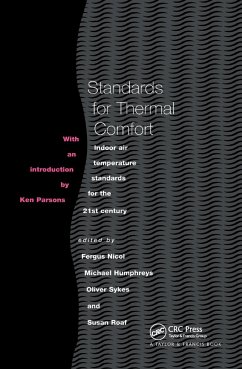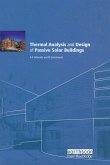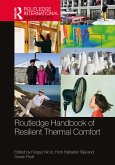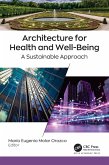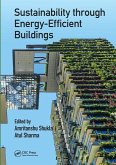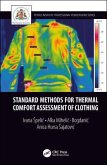M. Humphreys, F. Nicol, S. Roaf
Standards for Thermal Comfort
Indoor air temperature standards for the 21st century
M. Humphreys, F. Nicol, S. Roaf
Standards for Thermal Comfort
Indoor air temperature standards for the 21st century
- Broschiertes Buch
- Merkliste
- Auf die Merkliste
- Bewerten Bewerten
- Teilen
- Produkt teilen
- Produkterinnerung
- Produkterinnerung
Current Standards for Indoor Air Temperature are inappropriate in many regions of the world. This forces designers to use highly serviced buildings to achieve air temperatures that accord with the standards to the detriment of the local and global environment. Standards for Thermal Comfort brings together contributions from around the world, reflecting new approaches to the setting of standards which can apply to all climates and cultures.
Andere Kunden interessierten sich auch für
![Human Thermal Comfort Human Thermal Comfort]() Ken ParsonsHuman Thermal Comfort61,99 €
Ken ParsonsHuman Thermal Comfort61,99 €![Thermal Analysis and Design of Passive Solar Buildings Thermal Analysis and Design of Passive Solar Buildings]() AK AthienitisThermal Analysis and Design of Passive Solar Buildings51,99 €
AK AthienitisThermal Analysis and Design of Passive Solar Buildings51,99 €![Routledge Handbook of Resilient Thermal Comfort Routledge Handbook of Resilient Thermal Comfort]() Routledge Handbook of Resilient Thermal Comfort283,99 €
Routledge Handbook of Resilient Thermal Comfort283,99 €![Architecture for Health and Well-Being Architecture for Health and Well-Being]() Architecture for Health and Well-Being182,99 €
Architecture for Health and Well-Being182,99 €![Sustainability through Energy-Efficient Buildings Sustainability through Energy-Efficient Buildings]() Sustainability through Energy-Efficient Buildings51,99 €
Sustainability through Energy-Efficient Buildings51,99 €![Elevator Traffic Handbook Elevator Traffic Handbook]() Gina BarneyElevator Traffic Handbook51,99 €
Gina BarneyElevator Traffic Handbook51,99 €![Standard Methods for Thermal Comfort Assessment of Clothing Standard Methods for Thermal Comfort Assessment of Clothing]() Ivana Spelic (University of Zagreb Faculty of Textile Technology)Standard Methods for Thermal Comfort Assessment of Clothing301,99 €
Ivana Spelic (University of Zagreb Faculty of Textile Technology)Standard Methods for Thermal Comfort Assessment of Clothing301,99 €-
-
-
Current Standards for Indoor Air Temperature are inappropriate in many regions of the world. This forces designers to use highly serviced buildings to achieve air temperatures that accord with the standards to the detriment of the local and global environment. Standards for Thermal Comfort brings together contributions from around the world, reflecting new approaches to the setting of standards which can apply to all climates and cultures.
Produktdetails
- Produktdetails
- Verlag: Routledge / Taylor & Francis
- Seitenzahl: 247
- Erscheinungstermin: 5. September 2019
- Englisch
- Abmessung: 234mm x 157mm x 18mm
- Gewicht: 453g
- ISBN-13: 9780367401740
- ISBN-10: 0367401746
- Artikelnr.: 57733524
- Herstellerkennzeichnung
- Libri GmbH
- Europaallee 1
- 36244 Bad Hersfeld
- gpsr@libri.de
- Verlag: Routledge / Taylor & Francis
- Seitenzahl: 247
- Erscheinungstermin: 5. September 2019
- Englisch
- Abmessung: 234mm x 157mm x 18mm
- Gewicht: 453g
- ISBN-13: 9780367401740
- ISBN-10: 0367401746
- Artikelnr.: 57733524
- Herstellerkennzeichnung
- Libri GmbH
- Europaallee 1
- 36244 Bad Hersfeld
- gpsr@libri.de
Humphreys, M.; Nicol, F.; Roaf, S.; Sykes, O.
List of participants. Preface. Introduction -Dr Ken C Parsons. Session 1. Thermal comfort temperatures and the habits of Hobbits. Towards new indoor comfort temperatures for Pakistani buildings. Discussions to Session 1.
Session 2. Temperature standards for the tropics? New thermal comfort standard of the Czech Republic. Comfort, preferences or design data? Pale green, simple and user friendly: occupant perceptions of thermal comfort in office buildings. Designing for the individual: a radical reading of ISO 7730. An empirical model for predicting air movement preferred in warm office environments. Discussions to session 2.
Session 3. ISO standards and thermal comfort: recent developments. Comfort and air movement in a naturally ventilated room. Thermal comfort in Thai air-conditioned and naturally ventilated offices. Thermal comfort in air-conditioned buildings in the tropics. Discussions to Session 3.
Session 4. Deliberate design. Discussions on human thermal comfort in Vietnam. Thermal comfort and temperature standards in Pakistan. Discussions to session 4.
Session 5. Comfort conditions in PASCOOL surveys. Comfort standards from field surveys in the leisure industry. What is thermal comfort in a naturally ventilated building? The energy implications of a climate-based indoor air temperature standard. An adaptive guideline for UK office temperatures. Discussions to session 5. Final plenary discussion.
Poster presentations. Design parameters of a non-air-conditioned passive solar house for cold climate of Srinager, India. Higher PMV causes higher energy consumption in air-conditioned buildings: a case study in Jakarta, Indonesia. Thermal comfort of factory workers in Northern India. Warm and sweaty: thermal comfort in two naturally ventilated offices in Sydney, NSW.
Session 2. Temperature standards for the tropics? New thermal comfort standard of the Czech Republic. Comfort, preferences or design data? Pale green, simple and user friendly: occupant perceptions of thermal comfort in office buildings. Designing for the individual: a radical reading of ISO 7730. An empirical model for predicting air movement preferred in warm office environments. Discussions to session 2.
Session 3. ISO standards and thermal comfort: recent developments. Comfort and air movement in a naturally ventilated room. Thermal comfort in Thai air-conditioned and naturally ventilated offices. Thermal comfort in air-conditioned buildings in the tropics. Discussions to Session 3.
Session 4. Deliberate design. Discussions on human thermal comfort in Vietnam. Thermal comfort and temperature standards in Pakistan. Discussions to session 4.
Session 5. Comfort conditions in PASCOOL surveys. Comfort standards from field surveys in the leisure industry. What is thermal comfort in a naturally ventilated building? The energy implications of a climate-based indoor air temperature standard. An adaptive guideline for UK office temperatures. Discussions to session 5. Final plenary discussion.
Poster presentations. Design parameters of a non-air-conditioned passive solar house for cold climate of Srinager, India. Higher PMV causes higher energy consumption in air-conditioned buildings: a case study in Jakarta, Indonesia. Thermal comfort of factory workers in Northern India. Warm and sweaty: thermal comfort in two naturally ventilated offices in Sydney, NSW.
List of participants. Preface. Introduction -Dr Ken C Parsons.Session 1.
Thermal comfort temperatures and the habits of Hobbits. Towards new indoor
comfort temperatures for Pakistani buildings. Discussions to Session 1.
Session 2. Temperature standards for the tropics? New thermal comfort
standard of the Czech Republic. Comfort, preferences or design data? Pale
green, simple and user friendly: occupant perceptions of thermal comfort in
office buildings. Designing for the individual: a radical reading of ISO
7730. An empirical model for predicting air movement preferred in warm
office environments. Discussions to session 2.
Session 3. ISO standards and thermal comfort: recent developments. Comfort
and air movement in a naturally ventilated room. Thermal comfort in Thai
air-conditioned and naturally ventilated offices. Thermal comfort in
air-conditioned buildings in the tropics. Discussions to Session 3.
Session 4. Deliberate design. Discussions on human thermal comfort in
Vietnam. Thermal comfort and temperature standards in Pakistan. Discussions
to session 4.
Session 5. Comfort conditions in PASCOOL surveys. Comfort standards from
field surveys in the leisure industry. What is thermal comfort in a
naturally ventilated building? The energy implications of a climate-based
indoor air temperature standard. An adaptive guideline for UK office
temperatures. Discussions to session 5. Final plenary discussion.
Poster presentations. Design parameters of a non-air-conditioned passive
solar house for cold climate of Srinager, India. Higher PMV causes higher
energy consumption in air-conditioned buildings: a case study in Jakarta,
Indonesia. Thermal comfort of factory workers in Northern India. Warm and
sweaty: thermal comfort in two naturally ventilated offices in Sydney, NSW.
Thermal comfort temperatures and the habits of Hobbits. Towards new indoor
comfort temperatures for Pakistani buildings. Discussions to Session 1.
Session 2. Temperature standards for the tropics? New thermal comfort
standard of the Czech Republic. Comfort, preferences or design data? Pale
green, simple and user friendly: occupant perceptions of thermal comfort in
office buildings. Designing for the individual: a radical reading of ISO
7730. An empirical model for predicting air movement preferred in warm
office environments. Discussions to session 2.
Session 3. ISO standards and thermal comfort: recent developments. Comfort
and air movement in a naturally ventilated room. Thermal comfort in Thai
air-conditioned and naturally ventilated offices. Thermal comfort in
air-conditioned buildings in the tropics. Discussions to Session 3.
Session 4. Deliberate design. Discussions on human thermal comfort in
Vietnam. Thermal comfort and temperature standards in Pakistan. Discussions
to session 4.
Session 5. Comfort conditions in PASCOOL surveys. Comfort standards from
field surveys in the leisure industry. What is thermal comfort in a
naturally ventilated building? The energy implications of a climate-based
indoor air temperature standard. An adaptive guideline for UK office
temperatures. Discussions to session 5. Final plenary discussion.
Poster presentations. Design parameters of a non-air-conditioned passive
solar house for cold climate of Srinager, India. Higher PMV causes higher
energy consumption in air-conditioned buildings: a case study in Jakarta,
Indonesia. Thermal comfort of factory workers in Northern India. Warm and
sweaty: thermal comfort in two naturally ventilated offices in Sydney, NSW.
List of participants. Preface. Introduction -Dr Ken C Parsons. Session 1. Thermal comfort temperatures and the habits of Hobbits. Towards new indoor comfort temperatures for Pakistani buildings. Discussions to Session 1.
Session 2. Temperature standards for the tropics? New thermal comfort standard of the Czech Republic. Comfort, preferences or design data? Pale green, simple and user friendly: occupant perceptions of thermal comfort in office buildings. Designing for the individual: a radical reading of ISO 7730. An empirical model for predicting air movement preferred in warm office environments. Discussions to session 2.
Session 3. ISO standards and thermal comfort: recent developments. Comfort and air movement in a naturally ventilated room. Thermal comfort in Thai air-conditioned and naturally ventilated offices. Thermal comfort in air-conditioned buildings in the tropics. Discussions to Session 3.
Session 4. Deliberate design. Discussions on human thermal comfort in Vietnam. Thermal comfort and temperature standards in Pakistan. Discussions to session 4.
Session 5. Comfort conditions in PASCOOL surveys. Comfort standards from field surveys in the leisure industry. What is thermal comfort in a naturally ventilated building? The energy implications of a climate-based indoor air temperature standard. An adaptive guideline for UK office temperatures. Discussions to session 5. Final plenary discussion.
Poster presentations. Design parameters of a non-air-conditioned passive solar house for cold climate of Srinager, India. Higher PMV causes higher energy consumption in air-conditioned buildings: a case study in Jakarta, Indonesia. Thermal comfort of factory workers in Northern India. Warm and sweaty: thermal comfort in two naturally ventilated offices in Sydney, NSW.
Session 2. Temperature standards for the tropics? New thermal comfort standard of the Czech Republic. Comfort, preferences or design data? Pale green, simple and user friendly: occupant perceptions of thermal comfort in office buildings. Designing for the individual: a radical reading of ISO 7730. An empirical model for predicting air movement preferred in warm office environments. Discussions to session 2.
Session 3. ISO standards and thermal comfort: recent developments. Comfort and air movement in a naturally ventilated room. Thermal comfort in Thai air-conditioned and naturally ventilated offices. Thermal comfort in air-conditioned buildings in the tropics. Discussions to Session 3.
Session 4. Deliberate design. Discussions on human thermal comfort in Vietnam. Thermal comfort and temperature standards in Pakistan. Discussions to session 4.
Session 5. Comfort conditions in PASCOOL surveys. Comfort standards from field surveys in the leisure industry. What is thermal comfort in a naturally ventilated building? The energy implications of a climate-based indoor air temperature standard. An adaptive guideline for UK office temperatures. Discussions to session 5. Final plenary discussion.
Poster presentations. Design parameters of a non-air-conditioned passive solar house for cold climate of Srinager, India. Higher PMV causes higher energy consumption in air-conditioned buildings: a case study in Jakarta, Indonesia. Thermal comfort of factory workers in Northern India. Warm and sweaty: thermal comfort in two naturally ventilated offices in Sydney, NSW.
List of participants. Preface. Introduction -Dr Ken C Parsons.Session 1.
Thermal comfort temperatures and the habits of Hobbits. Towards new indoor
comfort temperatures for Pakistani buildings. Discussions to Session 1.
Session 2. Temperature standards for the tropics? New thermal comfort
standard of the Czech Republic. Comfort, preferences or design data? Pale
green, simple and user friendly: occupant perceptions of thermal comfort in
office buildings. Designing for the individual: a radical reading of ISO
7730. An empirical model for predicting air movement preferred in warm
office environments. Discussions to session 2.
Session 3. ISO standards and thermal comfort: recent developments. Comfort
and air movement in a naturally ventilated room. Thermal comfort in Thai
air-conditioned and naturally ventilated offices. Thermal comfort in
air-conditioned buildings in the tropics. Discussions to Session 3.
Session 4. Deliberate design. Discussions on human thermal comfort in
Vietnam. Thermal comfort and temperature standards in Pakistan. Discussions
to session 4.
Session 5. Comfort conditions in PASCOOL surveys. Comfort standards from
field surveys in the leisure industry. What is thermal comfort in a
naturally ventilated building? The energy implications of a climate-based
indoor air temperature standard. An adaptive guideline for UK office
temperatures. Discussions to session 5. Final plenary discussion.
Poster presentations. Design parameters of a non-air-conditioned passive
solar house for cold climate of Srinager, India. Higher PMV causes higher
energy consumption in air-conditioned buildings: a case study in Jakarta,
Indonesia. Thermal comfort of factory workers in Northern India. Warm and
sweaty: thermal comfort in two naturally ventilated offices in Sydney, NSW.
Thermal comfort temperatures and the habits of Hobbits. Towards new indoor
comfort temperatures for Pakistani buildings. Discussions to Session 1.
Session 2. Temperature standards for the tropics? New thermal comfort
standard of the Czech Republic. Comfort, preferences or design data? Pale
green, simple and user friendly: occupant perceptions of thermal comfort in
office buildings. Designing for the individual: a radical reading of ISO
7730. An empirical model for predicting air movement preferred in warm
office environments. Discussions to session 2.
Session 3. ISO standards and thermal comfort: recent developments. Comfort
and air movement in a naturally ventilated room. Thermal comfort in Thai
air-conditioned and naturally ventilated offices. Thermal comfort in
air-conditioned buildings in the tropics. Discussions to Session 3.
Session 4. Deliberate design. Discussions on human thermal comfort in
Vietnam. Thermal comfort and temperature standards in Pakistan. Discussions
to session 4.
Session 5. Comfort conditions in PASCOOL surveys. Comfort standards from
field surveys in the leisure industry. What is thermal comfort in a
naturally ventilated building? The energy implications of a climate-based
indoor air temperature standard. An adaptive guideline for UK office
temperatures. Discussions to session 5. Final plenary discussion.
Poster presentations. Design parameters of a non-air-conditioned passive
solar house for cold climate of Srinager, India. Higher PMV causes higher
energy consumption in air-conditioned buildings: a case study in Jakarta,
Indonesia. Thermal comfort of factory workers in Northern India. Warm and
sweaty: thermal comfort in two naturally ventilated offices in Sydney, NSW.

